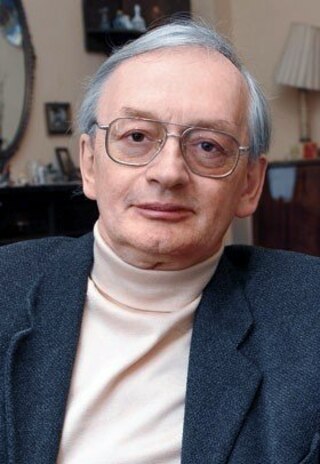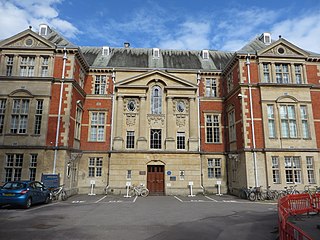
A physicist is a scientist who specializes in the field of physics, which encompasses the interactions of matter and energy at all length and time scales in the physical universe. Physicists generally are interested in the root or ultimate causes of phenomena, and usually frame their understanding in mathematical terms. They work across a wide range of research fields, spanning all length scales: from sub-atomic and particle physics, through biological physics, to cosmological length scales encompassing the universe as a whole. The field generally includes two types of physicists: experimental physicists who specialize in the observation of natural phenomena and the development and analysis of experiments, and theoretical physicists who specialize in mathematical modeling of physical systems to rationalize, explain and predict natural phenomena.

Lev Davidovich Landau was a Soviet physicist who made fundamental contributions to many areas of theoretical physics. He was also involved in the design of the Soviet atomic bomb.

Vitaly Lazarevich Ginzburg, ForMemRS was a Russian physicist who was honored with the Nobel Prize in Physics in 2003, together with Alexei Abrikosov and Anthony Leggett for their "pioneering contributions to the theory of superconductors and superfluids."

Alexei Alexeyevich Abrikosov was a Soviet, Russian and American theoretical physicist whose main contributions are in the field of condensed matter physics. He was the co-recipient of the 2003 Nobel Prize in Physics, with Vitaly Ginzburg and Anthony James Leggett, for theories about how matter can behave at extremely low temperatures.

The Institute for Theoretical and Experimental Physics is a multi-disciplinary research center located in Moscow, Russia. ITEP carries out research in the fields of theoretical and mathematical physics, astrophysics, high energy particle physics, nuclear physics, plasma physics, solid state physics, nanotechnology, reactor and accelerator physics, medical physics, and computer science. ITEP also maintains an extensive educational program and organizes physics schools for scholars and undergraduates. The institute is located near the corner of the Sevastopol prospect and the Nachimowski prospect and occupies part of the former estate "Cheryomushki-Znamenskoye" – an 18th-century manor that is a monument of architecture and landscape art of the 18th–19th centuries.

The L. D. Landau Institute for Theoretical Physics of the Russian Academy of Sciences is a research institution, located in the small town of Chernogolovka near Moscow.

Moscow Institute of Physics and Technology, is a public research university located in Moscow Oblast, Russia. It prepares specialists in theoretical and applied physics, applied mathematics and related disciplines.

Alexander Markovich Polyakov is a Russian theoretical physicist, formerly at the Landau Institute in Moscow and, since 1989, at Princeton University, where he is the Joseph Henry Professor of Physics Emeritus.

Yakov Grigorevich Sinai is a Russian–American mathematician known for his work on dynamical systems. He contributed to the modern metric theory of dynamical systems and connected the world of deterministic (dynamical) systems with the world of probabilistic (stochastic) systems. He has also worked on mathematical physics and probability theory. His efforts have provided the groundwork for advances in the physical sciences.

Sir Thomas Walter Bannerman Kibble was a British theoretical physicist, senior research investigator at the Blackett Laboratory and Emeritus Professor of Theoretical Physics at Imperial College London. His research interests were in quantum field theory, especially the interface between high-energy particle physics and cosmology. He is best known as one of the first to describe the Higgs mechanism, and for his research on topological defects. From the 1950s he was concerned about the nuclear arms race and from 1970 took leading roles in promoting the social responsibility of the scientist.
Dmitri Dmitrievich Ivanenko was a Soviet theoretical physicist of Ukrainian origin who made great contributions to the physical science of the twentieth century, especially to nuclear physics, field theory, and gravitation theory. He worked in the Poltava Gravimetric Observatory of the Institute of Geophysics of NAS of Ukraine, was the head of the Theoretical Department Ukrainian Physico-Technical Institute in Kharkiv, Head of the Department of Theoretical Physics of the Kharkiv Institute of Mechanical Engineering. Professor of University of Kharkiv, Professor of Moscow State University.
Thomas Fink is an Anglo-American physicist, author and entrepreneur. He has published papers in statistical physics and its applications, written two books and designed an iPhone app. He set up the London Institute for Mathematical Sciences and is a manager of research at the French National Centre for Scientific Research.
The C. N. Yang Institute of Theoretical Physics (YITP) is a research center at Stony Brook University. In 1965, it was the vision of then University President J.S. Toll and Physics Department chair T.A. Pond to create an institute for theoretical physics and invite the famous physicist Chen Ning Yang from Institute for Advanced Study to serve as its director with the Albert Einstein Professorship of Physics. While the center is often referred to as "YITP", this can be confusing as YITP also stands for the Yukawa Institute for Theoretical Physics in Japan.
Valery Leonidovich Pokrovsky is a Soviet and Russian physicist. He is a member of the Landau Institute in Chernogolovka near Moscow in Russia and a Distinguished Professor of Theoretical Physics and holder of the William R. Thurman ’58 Chair in Physics at Texas A&M University. He has twice received the Landau Prize of the Soviet Academy of Science, in 1984 and in 2018.

Alexey Andreevich Anselm was a Russian theoretical physicist, Doctor of Physical and Mathematical Sciences, professor, director (1992–1994) of the B.P. Konstantinov Petersburg Nuclear Physics Institute (PNPI), member of: the Russian and American Physical Society, the executive committee of the Nuclear Physics Branch of the Russian Academy of Sciences, the editorial board of the Russian journal “Yadernaya Fizika”.
Alexander "Sasha" Abramovich Belavin is a Russian physicist, known for his contributions to string theory.

Alexei Alexandrovich Starobinsky was a Soviet and Russian theoretical physicist and cosmologist. He was a pioneer of the theory of cosmic inflation, for which he received the 2014 Kavli Prize in Astrophysics together with Alan Guth and Andrei Linde.

The Department of Physics at the University of Oxford is located on Parks Road in Oxford, England. The department consists of multiple buildings and sub-departments including the Clarendon Laboratory, Denys Wilkinson's building, Dobson Square and the Beecroft building. Each of these facilities contribute in studying different sub-types of physics such as Atomic and Laser Physics, Astrophysics, Theoretical Physics, etc. The physics division have made scientific contributions towards this branch of science since the establishment of the department.

The School of Physics and Technology is one of the four physics schools of the V. N. Karazin Kharkiv National University. It specializes in the fields of theoretical physics, nuclear physics, plasma physics, materials science and medical physics. Distinctive features of the school include close cooperation with the Kharkiv Institute of Physics and Technology, and fundamental theoretical training in style of the Landau school, to which many instructors of the faculty belong.
Xenia de la Ossa Osegueda is a theoretical physicist whose research focuses on mathematical structures that arise in string theory. She is a professor at Oxford's Mathematical Institute.














